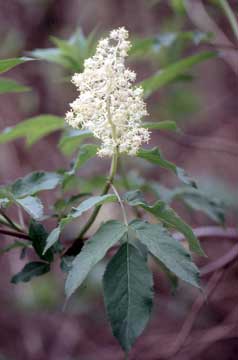 |
Western black elder, Sambucus racemosa
L. var. melanocarpa (A. Gray) McMinn (left and right),
and Western blue elder, Sambucus cerulea
Raf. (left and right, below). These two
western elders grow as shrubs or small trees. The plants are quite similar.
Both are native to most of our western states and Canadian provinces. Elders
prefer stream banks and permanently moist areas, growing as high as the subalpine
zone. Their compound leaves are odd pinnate, each has seven, stemless, toothed
leaflets. The flower clusters of the two species differ slightly. The black
elder has cone-shaped clusters, whereas blue elder’s flower cluster
is flat-topped. |
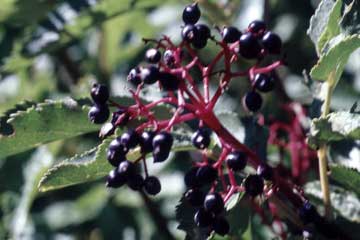 |
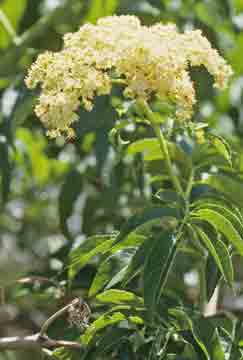 |
(Continued) The color of their fruit is reflected in their
names; the varietal name of the western black elder, melanocarpa,
means “black fruit” (above right) The species name of the blue
elder, cerulea, means blue for the color of the fruit (right). The
name, Sambucus, is the Latin name for an Old World elder; the species
name racemosa was derived from “raceme,” a botanical term
for a flower cluster that blooms from the bottom upward. Elderberries ripen
in late summer and may be used to make jellies and wine. |
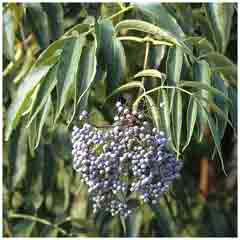 |
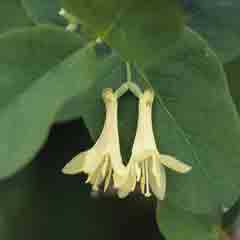 |
Utah honeysuckle, Lonicera
utahensis S. Watson. (left. right) The Utah
honeysuckle grows in the mountains of Idaho from mid-elevation nearly to
treeline. Its small flowers (left) are neatly paired and their ovaries mature
into two red berries (right) that sometimes fuse into hourglass-shaped
fruit. An attractive shrub, it is often used in ornamental landscaping. Lewis
and Clark collected a specimen of the Utah honeysuckle, most likely while
ascending the North Fork of the Salmon River, on September 2, 1805. |
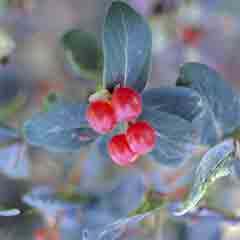 |
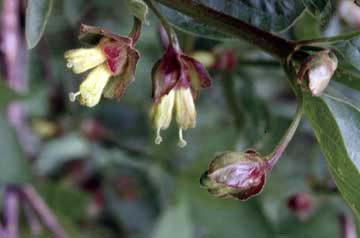 |
Twinberry, Lonicera
involucrata
(Richardson) Banks ex Spreng. (left, right) The twinberry is a shrub
found along water courses as high as the subalpine zone. Inconspicuous twinned
yellow flowers (left) appear in the spring and by mid-summer paired,
inedible, blue-black berries (right) have formed above two red leaves, or
“bracts.” These leaves are known as an “involucre” from
which the plant derives its species name. Under favorable conditions turn
a bright waxy scarlet as in our illustration. The genus
Lonicera—which takes its name from Adam Lonitzer (1528-1586),
a German botanist—consists of about 180 species. Meriwether Lewis collected
this plant near today’s misnamed Lewis and Clark Pass
(“misnamed” because only Lewis crossed the pass. William Clark
was far to the south, heading for the three forks of the Missouri River and
from there to the Yellowstone River) on the continental divide in Montana
during the expedition’s return journey (July 7, 1806). |
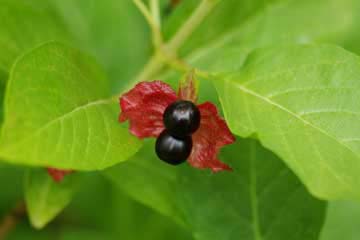 |
 |
Trumpet honeysuckle Lonicera
ciliosa, (Pursh) Poir. ex DC.
(left). The attractive, orange-flowered trumpet honeysuckle
vine is often seen growing along roadsides and trails to montane elevations.
It is identified by its clustered, bright orange, trumpet-shaped flowers
and by a pair of joined opposing leaves just below the flower cluster through
which the stem passes. The plant was unknown to science until Lewis and Clark
returned to the United States with a dried specimen that they had collected
on June 5, 1806, while camped on the Clearwater River near today’s Kamiah,
Idaho close to where this plant was photographed. |
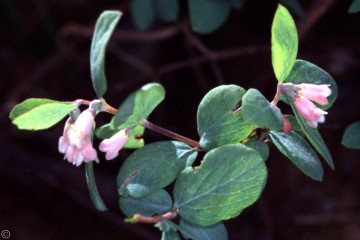 |
Common snowberry, Symphoricarpos albus
(L.) S. F. Blake var. laevigatus S. F. Blake
(Rydb.) A. Nels. (left, right).
The common snowberry grows at mid-elevations. It was unknown
to science until collected by the Lewis and Clark expedition, probably somewhere
along the Missouri River on an unknown date. The snowberry been used as an
ornamental shrub almost from the time the explorers’ specimen (dried
fruit) grew out from their seeds, planted in Philadelphia. The mushy
white berries have no food value. |
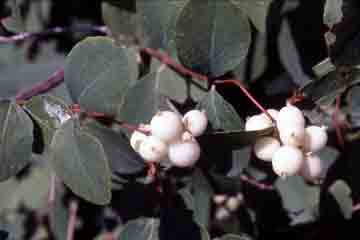 |
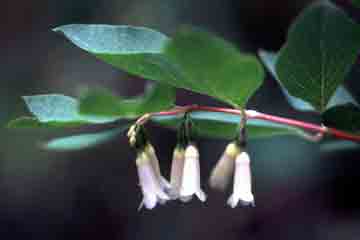 |
The Mountain Snowberry, Symphorocarpus
oreophilus var. utahensis (left,
right) replaces the common snowberry at higher altitudes. It is found all
along our hiking trails, and is easily recognized by its distinctive soft
blue-green oval leaves. In late spring the shrubs bear small white
tubular flowers, often in pairs, with petals that flare out a bit at the
end (left). The generic name Symphoricarpos is derived from two Greek
words that mean "fruit that is born together" in pairs.. The species name
oreophilus also is from the Greek and means "mountain lover." This
plant's berries (right) are smaller and oval in shape compared to those of
the common snowberry. |
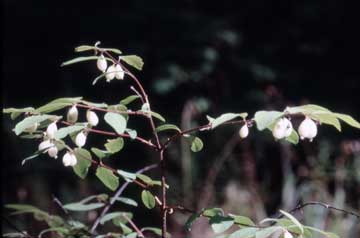 |












